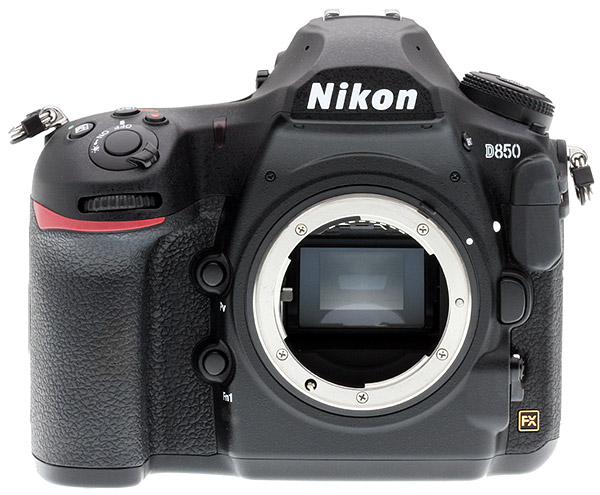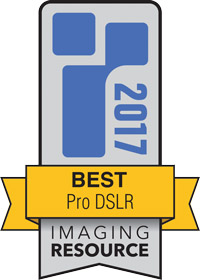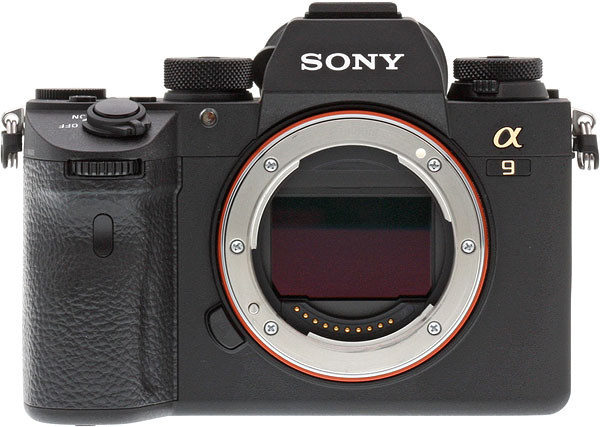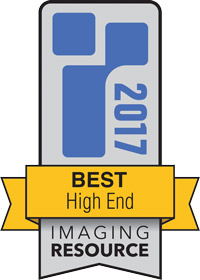Camera of the Year 2017: Best Professional & High-End Cameras
posted Monday, November 20, 2017 at 3:02 PM EDT

The top of the line from 2017, the State of the Art, that's what we'll be unveiling for you in this segment of our annual Camera of the Year awards. For those of you who make your living with high-end cameras, and for the rest of us who simply insist on buying the best for our craft, the cameras listed below are the models we believe represent the cream of the crop for 2017 in the digital camera world.
From the best DSLRs to the best the mirrorless cameras in the world, including the best for video and medium format, one of the models below is sure to fit the bill for your next wedding, portrait or sports-shooting gig. These represent vastly different market segments in many ways, although there is, of course, plenty of overlap between models as well. Whatever it is that you regularly shoot, one of these is bound to get you the best results.
Camera of the Year, Best Professional DSLR - Nikon D850

2017 has been a good year for Nikon. Not only is the company celebrating their 100th Anniversary, but during their centennial, the Japanese giant in the photography industry released perhaps their best all-around camera ever, the Nikon D850. That's a big claim when talking about a company with such an extensive history, but the D850 has proven to be a special DSLR. With mirrorless cameras seemingly gaining a bigger foothold every year, and with Nikon themselves stating that they're working on a new mirrorless camera, the Nikon D850 was not only a welcome addition to their DSLR lineup, but likely also a necessary one.

With a brand-new, backside-illuminated, 45.7-megapixel full-frame sensor, a weather-sealed body, 153-point autofocus system (the same one as is found in the Nikon D5 and D500), EXPEED 5 image processor, up to 9 frames per second of RAW shooting speed and full-width 4K UHD video, the D850 is one of the most versatile and well-rounded cameras we've seen. The D850 is as much at home in the studio doing commercial work as it is out in the backwoods shooting wildlife photography. With its 9 fps shooting (with optional battery grip), the D850 can more than handle itself as a sports camera, too. It's the entire package and then some.
The Nikon D800/D810 was a tough act to follow but Nikon has exceeded expectations and packed a lot of excellent features and performance into the D850's rugged DSLR body. The versatile Nikon D850 is a standout and is our 2017 Professional DSLR Camera of the Year.
Buy now: B&H | Amazon | Adorama
• • •
Camera of the Year, Best Professional Mirrorless - Sony A7R III

What do you get when you combine the already-fantastic A7R II with the amazing performance backbone of the flagship A9? The Sony A7R III, that's what. Despite using the same 42MP full-frame sensor as the A7R II, Sony paired it with the faster image processor of the A9 as well as made some circuitry changes that together help increase the dynamic range as well as improve high ISO performance. Plus, the A7R III now offers a Pixel Shift Multi Shooting mode, which captures four pixel-shifted images containing a total of 169.6 million pixels of data (later composited on the computer rather than in-camera) for even higher image quality. Needless to say, the camera's image quality performance makes it a dream camera for landscapes, astrophotography, architecture, portraits, and weddings to name a few.

If performance is your thing, however, don't let the high resolution of the A7R III give you the idea that this camera is in any way slow. The A9 is still faster, at 20fps, but the A7R III can capture 42MP images, even RAW, at up to 10fps -- significantly faster than the 5fps rate on the Mark II. For most action and sports scenarios, 10fps is plenty quick, and given the resolution you're capturing, that's just incredible. What's even better is the camera's AF system, which gains many of the performance specs of the A9, making it up to two times faster than the Mark II. The A7R III still includes an impressive 399 phase-detect AF points, but now also offers significantly more CDAF areas (425 from just 25) as well as the A9's faster Eye-AF mode. Overall, when you account for the burst rate and AF system as well as features like the A9's beefier battery and dual card slots, the Sony A7R III is a high-res camera that's also supremely capable of action, sports, and wildlife photography.
Sony's A7R family has been a consistent champion in our annual awards, and with the Mark III, the trend continues. The continual innovation and advancement of image quality, as well as sheer performance, put the new Sony A7R III at the top of the pack when it comes to a professional-grade mirrorless camera.
Buy now: B&H | Amazon | Adorama
Camera of Distinction, Professional Mirrorless - Panasonic G9

The GH-series has been Panasonic's flagship model for years, but with its ever-increasing popularity (and rightly so) as a professional video camera, room emerged for a more photo-centric flagship camera: The Panasonic G9. This high-performance Micro Four Thirds camera is packed with impressive specs: rugged weather-sealed body; 20MP sensor with an 80MP High-Res mode; 6.5-stop I.S. system; blazingly fast, 225-point AF system with customizable C-AF tracking parameters; up to 60fps burst shooting; dual UHS-II card slots; 6K Photo and much more.

Design-wise, the G9 is pretty beefy as far as Micro Four Thirds cameras are considered. The large handgrip, numerous physicals controls and rare (for a MFT camera) top-deck status LCD make the Panasonic G9 feel and operate very much like a DSLR -- which for us, is a positive quality. Those switching from DSLRs should feel right at home, while gaining the size and weight benefits of the Micro Four Thirds system. Overall, the Panasonic G9 feels great and works great. With excellent image quality, top-notch performance and rugged weather-sealing, the G9 competes with the Olympus E-M1 II head-on. Anyone looking for a high-performance yet compact camera system that can handle sports and wildlife should consider the Panasonic G9.
Buy now: B&H | Amazon | Adorama
• • •
Camera of the Year, Best High-End Camera - Sony A9

It is no easy feat to try and redefine what an industry comes to expect from a high-end camera, but Sony did that and then some with the A9. Not only did it successfully shirk the prior narrative regarding the autofocus capability of mirrorless cameras, it completely reset the bar for the entire camera industry. But it didn't stop there: the Sony A9 is legitimately revolutionary and reframes what we as photographers should consider possible.

The Sony A9 set a new standard for what "fast and accurate autofocus" meant, creating a benchmark by which all will now be judged. Sony’s new sensor features 693 autofocus points that accurately follows the subject across different depths and through obstacles. Beyond just tracking, it reacts quickly to movement and locks focus immediately in nearly any situation. The A9's incredible shooting speed of 20 frames per second is already impressive, but add to that its ability to do so blackout-free and in total silence means that the constant clicking of cameras could be totally eliminated, allowing for photographers to actually capture live professional golf matches as well as make watching press conferences on television much more pleasant. Additionally, thanks to a totally redesigned battery system (from a new battery through how the camera uses power), the A9 shrugged off the stigma of limited battery life and propensity for overheating that was so accurately pinned on the A7R II. When you combine the new features with the already-lauded Sony mainstays like in-body 5-axis stabilization, 4K video shooting and high ISO performance, the end result is unlike anything ever released.
In short, the Sony A9 stands clearly above all high-end cameras released in the past year, not just those in the mirrorless category. The culmination of years of research and development by Sony has resulted in a final product history will note as the first milestone showing the convergence of DSLR and mirrorless performance. For the first time, a mirrorless camera either matches or outperforms DSLRs when it comes to autofocus speed, accuracy and frames per second. Even if the A9 isn't for you, and it certainly is not for everyone, it's hard not to argue with its numerous achievements. Finally, a mirrorless isn't just portable and light -- it's reliable, powerful, and tough as well.
Buy now: B&H | Amazon | Adorama
• • •
Camera of the Year, Best Medium Format - Fujifilm GFX 50S

It's not often we are treated to a new medium format camera and 2017 brought us not one, but two new mirrorless medium format camera systems. For the ultimate in digital image quality, medium format has long been the standard bearer. However, the cameras were often out of reach for nearly all photographers due to their high cost and large, heavy bodies and lenses. With the GFX 50S, Fujifilm has created a medium format camera with a body not dissimilar from a full-frame DSLR and a price point, which while high, is competitive with flagship DSLRs.

With its incredible image quality, very good native lenses and excellent camera body, the Fujifilm GF X 50S has earned our Camera of the Year, Best Medium Format Camera Award for 2017. The GFX 50S uses a 50-megapixel image sensor and delivers photos with some of the best image quality we have ever seen. The Fujifilm GFX has taken home the top honor by delivering better value and a more robust camera body. Plus, while much slower than DSLRs, the GFX 50S is speedy for a medium format camera and does offer a level of versatility that is essentially unheard of for a medium format camera.
Part of the versatility comes from the camera's detachable electronic viewfinder, which proved to be one of the best EVFs we've used, and its tilting touchscreen display. Despite offering a much larger sensor than the Fujifilm X series cameras, the GFX offers much of the same in terms of user experience and physical controls. The weather-sealed Fujifilm GFX 50S is not only an excellent medium format camera, it is also a bold new step for Fujifilm. For the most discerning photographers, the Fujifilm GFX is tough to top.
Buy now: B&H | Amazon | Adorama
• • •
Camera of the Year, Best Still Camera for Video - Panasonic GH5

For a few years now, Panasonic has been producing cost-effective video cameras that have allowed creative professionals to produce high-quality video on what were low-quality budgets. There are few companies offering the feature sets that Panasonic crams into their GH series at a sub-$2000 price point, yet with each iteration, Panasonic adds more without raising their prices too much. The GH5 is the latest in that trend, and it offers the most impressive set of specifications that we’ve seen from them yet, and bests nearly every other camera that can be purchased for double the price when it comes to video.

Before the GH5, the only camera with the popular "DSLR-like" form factor that could shoot 4K at 60 frames per second was the Canon 1DX Mark II, and that camera is not light on the wallet. The GH5 brought slow-motion 4K capture to a smaller package, and did so without sacrifices. The Panasonic GH5 can capture super high resolution 4K video internally at 4:2:2 10 bit (capturing at 24/30p) while also not cropping the frame at all, in any frame rate. Additionally, Panasonic did wonders to "level out" the quality of footage captured on the GH5, regardless of quality or frame rate. The GH4 suffered from lower-quality 1080p video when compared to 4K capture, and this was especially noticeable when shooting at high frame rates. The GH5 has nearly no discernible loss in quality in any frame rate or resolution, allowing you to get the best look for whatever you shoot, however you want to shoot it. Panasonic also added 5-axis in-body image stabilization, which increases the number of possible use cases for the camera. From allowing you to hand-hold at slower shutter speeds when capturing stills, to allowing greater forgiveness when shooting hand-held video, in-body stabilization makes the GH5 dramatically more dynamic of a camera than any GH before it. Panasonic also added a second memory card slot, both operating at UHS-II speeds, to further expand the camera's functionality for all its shooters. But it didn't end there, Panasonic also increased the camera's performance in low light, allowing the GH5 to be used at even higher ISOs than its predecessor.
The list of improvements in the GH5 over the GH4 seems like it can go on forever, and we've only listed a few of the many things the GH5 can do. For video, it's far and away the best compact high-quality capture device that Panasonic has ever made. It remains the only camera in its form factor outside of the Canon 1DX Mark II that can capture 4Kp60, and it does so at a quarter the cost of that competitor product. When a video shooter looks at all the things that the Panasonic GH5 can do, and the remarkable price at which it can do it, the sky is nearly the limit on creative potential. And that's probably the concept of note worth walking away with: the GH5 does so much that it allows a videographer to focus on capturing a moment rather than fiddling with features or worrying about performance. The GH5 just… works. And that’s all any of us can ask for of from our tools.
Buy now: B&H | Amazon | Adorama
• • •
Imaging Resource Camera of the Year Awards 2017
Best Professional & High-End Cameras (current page)
Best Enthusiast & Premium Compact Cameras
Best Intermediate & Entry-Level Cameras















